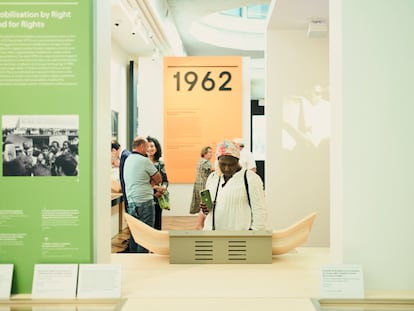Notre Dame, the cathedral that reinvented the Middle Ages
The inauguration of this Parisian landmark on Saturday, five years after the fire, reflects our enduring fascination with the era
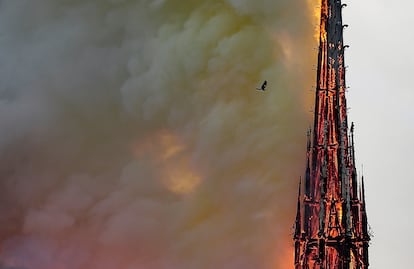

Victor Hugo’s most enduring cultural legacy is not Les Misérables and Jean Valjean’s struggle to find something resembling justice in a world that shows no mercy to the poor. The 19th century French author’s most profound mark on France, and the world, is a monumental Gothic cathedral, whose spires and rose windows are as iconic as the Eiffel Tower. To a large extent, the Notre Dame, which will be reopened on Saturday after burning to the ground in 2019, is of Victor Hugo’s making.
The Hunchback of Notre Dame, published in 1831, begins with the introduction of the beautiful gypsy Esmeralda, the hunchback Quasimodo, the archdeacon Claude Frollo, the enamored Pierre Gringoire and Captain Febo de Châteaupers... But suddenly, the novelist interrupts the narrative to speak about the desecrated state of the Parisian cathedral, which was so rickety, it looked as though it might collapse at any moment. Neither the Gothic nor the Middle Ages had been defended at that time, nor was there yet the idea that the monuments of the past should be preserved. In fact, they were often considered annoying monstrosities that had to be got rid of as soon as possible (a view that persists in some areas).
“The church of Notre Dame de Paris is still no doubt, a majestic and sublime edifice,” writes Hugo in The Hunchback of Notre Dame. “But, beautiful as it has been preserved in growing old, it is difficult not to sigh, not to wax indignant, before the numberless degradations and mutilations which time and men have both caused the venerable monument to suffer.”
The novelist launches into a vindication of medieval and Gothic art, accusing the authorities of being responsible for their decline, not only from a lack of conservation, but also due to the imposition of current tastes on the past. “Fashions have wrought more harm than revolutions,” he points out, in a phrase that could be applied to some of the barbarism inflicted on the Notre Dame.
The cathedral had survived the French Revolution, although it was then transformed into a pagan temple dedicated to the goddess reason, but the truth is that it was in bad shape. Hugo’s was not the only voice raised against the ruin of the iconic monument: it was not the church of the kings of France, crowned in Reims and buried in Saint-Denis, it was the church of Paris and its people.
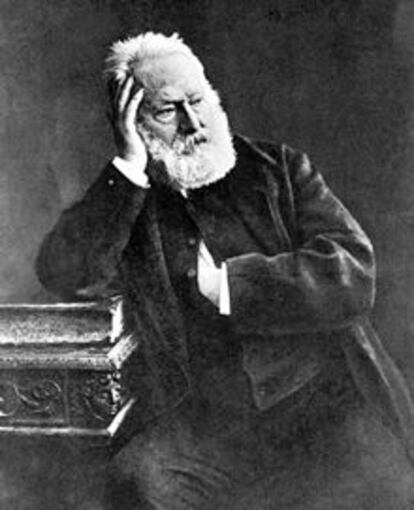
Thanks to Hugo’s efforts, Eugène-Emmanuel Viollet-le-Duc, an architect also fascinated by the Middle Ages, was able to undertake a massive restoration project. In fact, as the world watched the fire unfold live in astonishment, the point of no return — the moment when it seemed certain that Notre Dame would be lost — was marked by the collapse of its iconic spire, which was designed by Le-Duc. The spire was a masterwork inspired by a similar structure that had been lost two centuries earlier.
“Le-Duc was passionate about the Middle Ages,” said Didier Rykner, author of Notre-Dame. Une affaire d’etat (Notre-Dame. A Matter of State). “He tried to return the cathedral to the Middle Ages: to leave the monument not in the state it was in during the Middle Ages; but the state it should have been in at that time.” Several other sites in medieval France, from Carcassonne to Mont Saint-Michel — whether seen as stunning or verging on kitsch — were also restored by Le-Duc, who pioneered the notion of the Middle Ages as a pivotal era that shaped modern identity.
The fascination with Notre Dame and the global horror that followed its devastating fire are a testament not only to the power of mass tourism — 12 million visitors explored the cathedral the year before the tragedy — but also to our enduring intrigue with the Middle Ages. This reinvention of the Middle Ages was a movement that emerged in the 19th century, spurred on by works like Walter Scott’s Ivanhoe. The Middle Ages’ influence on contemporary culture is undeniable, shaping everything from literary successes like Umberto Eco’s The Name of the Rose and Tolkien’s The Lord of the Rings to hit series such as Game of Thrones and Vikings. The period’s legacy also reverberates through modern politics.
Only Ancient Rome rivals the Middle Ages in the prominence the distant past holds in the present. However, the appropriation of the Middle Ages by right-wing and far-right groups has transformed it into a tool for conjuring an imagined past rather than a subject for historical study.
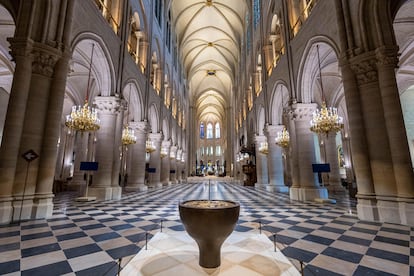
The Middle Ages are often portrayed through two starkly contrasting lenses. On one hand, they are presented as a period filled with violence and darkness — a grim tableau of rotten teeth and witch hunts. In reality, many of the calamities commonly associated with the medieval period are better attributed to the upheavals of the 16th and 17th centuries, considered the most catastrophic in European history. On the other hand, the Middle Ages are seen as a pivotal epoch for understanding the present, frequently invoked to reinforce the notion that Europe’s identity is intrinsically tied to Christianity.
It is an idea that clashes with reality, as scholar Eduardo Manzano Moreno has shown in his latest book, España diversa (Diverse Spain), but which the right returns to again and again. When the possibility of charging admission to enter Notre Dame was first raised, Jordan Bardella, leader of France’s ultra-right National Rally party, expressed his support for the measure with the following argument: “The history of France has been shaped by Christianity. Today, seeing our churches falling into ruin hurts many French people.”
“In a context of renewed nationalism and tensions over identity, the signs of which were already perceptible in the early 2000s but which have gained considerable momentum since, the medieval period is often claimed by nationalists and populists as the founding moment of the cultural, religious and even ethnic nation they seek to protect from globalization and multiculturalism,” writes French medievalist Florian Mazel in his recent book Nouvelle histoire du Moyen Age (New History of the Middle Ages).
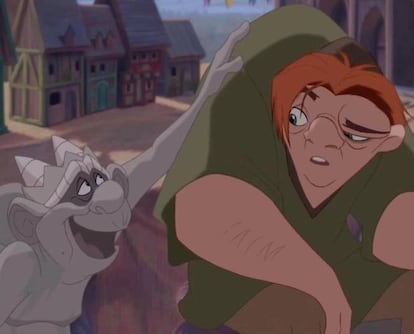
Notre Dame stands as a symbol of the real and imagined Middle Ages, as a civic space that goes far beyond its religious role, given its immeasurable beauty, its resounding presence on the banks of the Seine on the Île de la Cité and its ability to survive disasters through the ages — it was saved from the burning of Paris after the defeat of the Commune in 1871 and survived World War II intact when so many European cathedrals were reduced to mountains of rubble. All the tensions, false perceptions and reinterpretations of the medieval past have run through the complex restoration of the French cathedral. But the stone, and Victor Hugo’s struggle, have proved stronger than all that.
“The fire revealed to a flattered yet perplexed secular France the worldwide dimension of Notre Dame’s glory, far beyond the Western Christianity that Notre Dame embodies above all else,” writes historian Maryvonne Saint Pulgent in La Gloire de Notre-Dame. La foi et le pouvoir (The Glory of Notre Dame. Faith and Power). “Secular and religious, multiform, evolving, eternally modern, the glory of Notre Dame is not entirely explicable. As many writers have pointed out, it is not the most beautiful of our cathedrals. But it is the most admired.”
Sign up for our weekly newsletter to get more English-language news coverage from EL PAÍS USA Edition
Tu suscripción se está usando en otro dispositivo
¿Quieres añadir otro usuario a tu suscripción?
Si continúas leyendo en este dispositivo, no se podrá leer en el otro.
FlechaTu suscripción se está usando en otro dispositivo y solo puedes acceder a EL PAÍS desde un dispositivo a la vez.
Si quieres compartir tu cuenta, cambia tu suscripción a la modalidad Premium, así podrás añadir otro usuario. Cada uno accederá con su propia cuenta de email, lo que os permitirá personalizar vuestra experiencia en EL PAÍS.
¿Tienes una suscripción de empresa? Accede aquí para contratar más cuentas.
En el caso de no saber quién está usando tu cuenta, te recomendamos cambiar tu contraseña aquí.
Si decides continuar compartiendo tu cuenta, este mensaje se mostrará en tu dispositivo y en el de la otra persona que está usando tu cuenta de forma indefinida, afectando a tu experiencia de lectura. Puedes consultar aquí los términos y condiciones de la suscripción digital.
More information
Archived In
Últimas noticias
Most viewed
- Reinhard Genzel, Nobel laureate in physics: ‘One-minute videos will never give you the truth’
- Oona Chaplin: ‘I told James Cameron that I was living in a treehouse and starting a permaculture project with a friend’
- Pablo Escobar’s hippos: A serious environmental problem, 40 years on
- Charles Dubouloz, mountaineering star, retires at 36 with a farewell tour inspired by Walter Bonatti
- Why we lost the habit of sleeping in two segments and how that changed our sense of time
